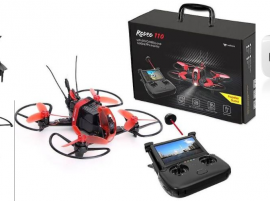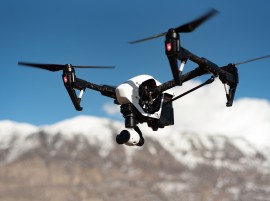How to Fly a Drone – Drones Technology Guide 2020
Is It Difficult to Fly a Drone?
When flying a drone for the first time, everyone goes through their own struggle. Whether you have flown one before or are a beginner, you’ve come to the right place. This guide explains some of the basic and advanced flying techniques and will get you ready for your first flight. It will also help you stay safe.
With this guide, you can take out the guess work because it includes a pre-flight checklist, beginner techniques, an overview of the controls, and some safety guidelines.
Let’s begin.
Learning How to Use a Drone Remote Control or Transmitter
 The controls of your drone are essential to learning how to fly.
The controls of your drone are essential to learning how to fly.
Once you get the hang of how they interact together and individually, they will become second nature to forming a flying experience that is complete.
The harder the stick is pushed, the stronger the drone will move in either direction with any of the controls. When starting out, gently push the sticks so the drone only makes slight movements. You can gradually make sharper movements when you get more comfortable.
The Four Main Drone Controls:
● Pitch
● Throttle
● Roll
● Yaw
Let’s go over each control.
Pitch To use the pitch, the right stick on the transmitter is pushed forwards or backwards. This will cause the drone to tilt, which results in movement forwards or backwards.
To use the pitch, the right stick on the transmitter is pushed forwards or backwards. This will cause the drone to tilt, which results in movement forwards or backwards.
Throttle
Throttle gives the drone propellers power to get airborne. Once in the air, the throttle must be constantly engaged.
The left stick on the transmitter should be pushed forward to engage the throttle. Pull it backwards to disengage.
The throttle should not be completely disengaged until the drone is a couple of inches from the ground. If it’s disengaged sooner, it could become damaged.
Roll
The roll control will move the drone right or left. To use the roll, push the stick on the right of the transmitter either left or right.
The reason why it’s called a “roll” is because it actually rolls the drone.
Yaw
Yaw is what rotates the drone clockwise and counterclockwise.
To use the yaw, the left stick is pushed to the left or right.
Typically, yaw is used during continuous flight, at the same time as the throttle. By using yaw, circles and patterns can be made by the pilot. It’s helpful for photographers and videographers to follow objects that could change direction.
Learn Your Drone: Differences in Controls
A drone uses a transmitter which is a hand-held controller that allows you to pilot its flight pattern. By making adjustments with the sticks, a signal is sent to the drone telling it how to perform.
Transmitters have different features and come in different sizes and shapes, as well. However, some parts of every transmitter are universal.
Right Stick
Pitch and roll are controlled with the right stick. It will move the drone backwards/forwards and left/right.
Left Stick
Throttle and yaw are controlled with the left stick. It will adjust the height at which the drone is flying as well as move it clockwise or counterclockwise.
Trim Buttons
Every control has a trim button. When the throttle is first used to get the drone off the ground, it may tilt and fly to one direction automatically. This is what happens with unbalanced controls. To get them balanced, some controls should be trimmed.
When this happens, the corresponding trim button can be used to adjust the natural intensity of the control. This stabilizes the drone when the throttle is pushed.
Learn to Fly a Drone: Beginner Techniques
Here are a few flying techniques for beginners to master:
● Fly the drone in a circle
● Fly the drone in a square pattern
● Hover the drone in place
● Fly at different altitudes
● Rotate and hover the drone
● Create two ground targets and land on each of them repeatedly
● Rotate the drone at different angles, fly it forwards/backwards and left/right until it becomes comfortable to fly it without it facing your direction
Weather Conditions & Site Safety Checklist
Here is a short checklist you should run through to make sure weather conditions and the site you have chosen are both safe for flying:
● Cloud base of at least 500 feet
● Less than 10% chance of precipitation
● Check for any potential electromagnetic interference
● Visibility should be at least 3 miles
● Wind speed should be under 20mph
● Look for any nearby trees, towers, buildings, wires, or other obstacles
● Check for any nearby animals and/or people and create a safety perimeter, if needed
● If flying at dusk or dawn, check the civil twilight hours
● Establish zones for take-off, landing and emergency hovering
● Discuss your flight mission with others present
Advanced Flying Techniques
Here are some flying techniques to master that are advanced.
1. Fly the drone in the pattern of a “figure 8.” This will require the front of the drone to be facing forward the whole time.
2. Bank turns. Keep the pitch control a little forward to create forward movement. Use the throttle and roll the drone in the direction of the turn.
Pre-Flight Checklist
 Going over a drone pre-flight checklist will keep everything and everyone safe.
Going over a drone pre-flight checklist will keep everything and everyone safe.
Here’s a checklist you should use each time before flying:
System Inspection and Visual Aircraft
● Remove the lens caps and gimbal clamp
● Clean the lenses with a soft cloth
● Look for any abnormalities in the transmitter, camera, gimbal, payloads, etc.
● Look for any abnormalities in the motors, frame, propellers, undercarriage, etc.
● Make sure the registration number is legible and displayed properly
● Attach the fuel/battery source and propellers
● Insert lens filters and SD card
Power Up
● Turn on remote control or transmitter
● Turn on the drone
● Position the transmitter antennas toward the sky
● Verify the transmitter and drone are connected
● Verify the FPV screen or display panel are properly functioning
● Calibrate the IMU (inertial measurement unit), if needed
● Calibrate the compass
● Verify that the drone has acquired at least six satellite GPS locations
● Verify the fuel and battery levels on the drone and transmitter
Take Off
● Fly the drone for about 10-15 seconds at eye-level altitude
● Listen for any sound abnormalities
● Look for any irregularities or imbalances
● Test the control response of the roll, pitch and yaw sensitivity
● Check for any software warnings or electromagnetic interference
● Do a final check to make sure the area you are going to operate in is safe
● Proceed with your flight mission
Remember the Rules & Regulations
The rules and regulations associated with operating a drone can be difficult to understand. Here is an outline of basic rules you should follow to fly responsibly and safely in most situations and areas worldwide.
- Stay below 400 feet, the maximum altitude allowed.
How high can a drone be flown? A general rule the aviation authorities set for maximum altitude of drones is below 400 feet. This will help avoid any possible conflict with other aircraft such as helicopters and planes.
Make sure to check with your local aviation authority as rules can vary from one country to another. It is always your responsibility to ensure your drone stays within the safety limit.
- Don’t fly over people.
Flying drones over people is not permitted even though the beach might seem like a fun place to capture some images. This includes single people who are not part of the flight crew, as well as groups. Use common sense and be sure to steer clear of public events, stadiums, community gatherings or anywhere people may gather in groups to congregate.
- Check your local community-based guidelines.
Your city, county or state may have its own set of regulations when it comes to flying drones. Contact your local authority to make sure you are abiding by and observing the rules. If your local area does not have any drone regulations, you can use the rules laid out by the aviation authority in your country, like the FAA.
- Maintain the drone in your line of sight.
The drone should always be within your line of sight. Never rely on the FPV camera solely or visual aides like telescopes, binoculars, etc. Make sure the weather conditions won’t impede your vision beforehand, such as fog and clouds.
- Give the airport notice if you are flying within 5 miles of it.
If you wish to fly a drone within 5 miles of an airport, notice must be given to two entities before the flight:
1. The airport manager or operator AND
2. Air traffic control
- Don’t fly after it becomes dark.
Never fly your drone after dark, even if it is equipped with lights. Dark is 30 minutes after the official sunset and 30 minutes before the official sunrise, known as civil twilight.
Conclusion
These are the general steps you should perform before each flight. You may need to customize it to fit your needs more closely. For example, if you are going to use filters, you will want to make sure you have the right ones with you.
Remember to have fun and true mastery of drone flying comes with time. Most importantly, when flying your drone, always stay safe!







